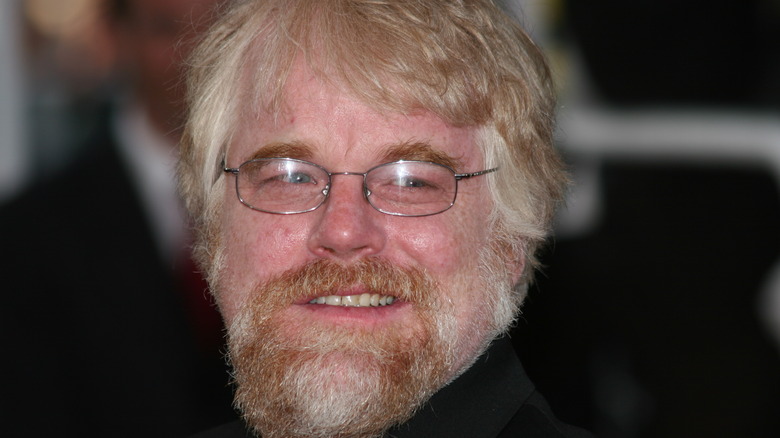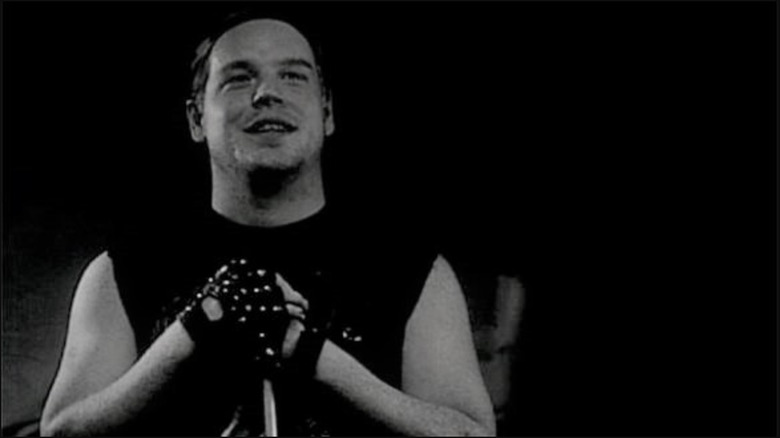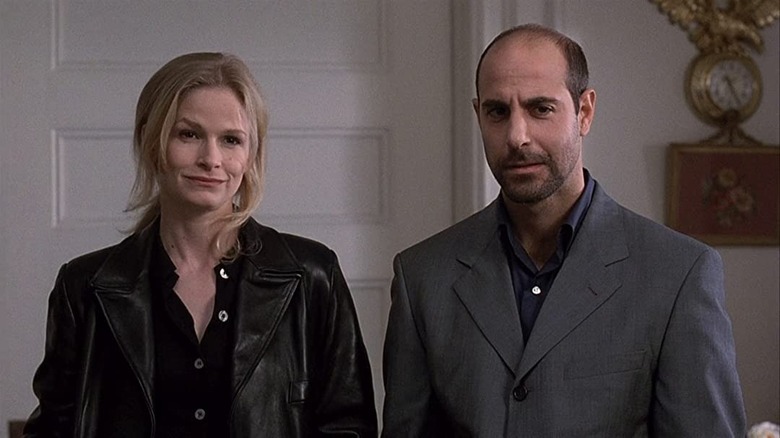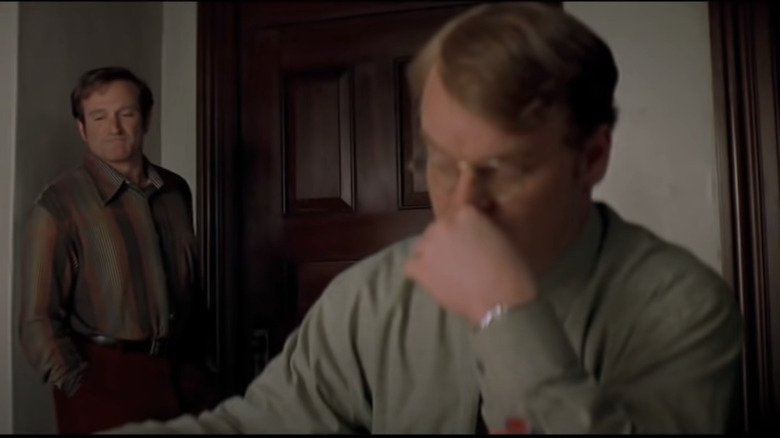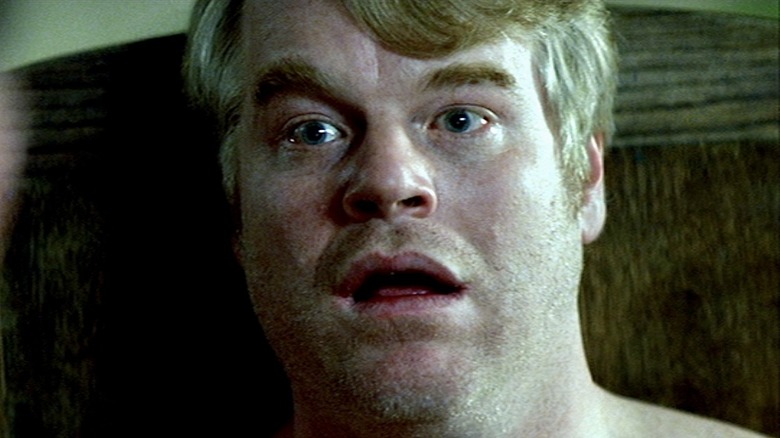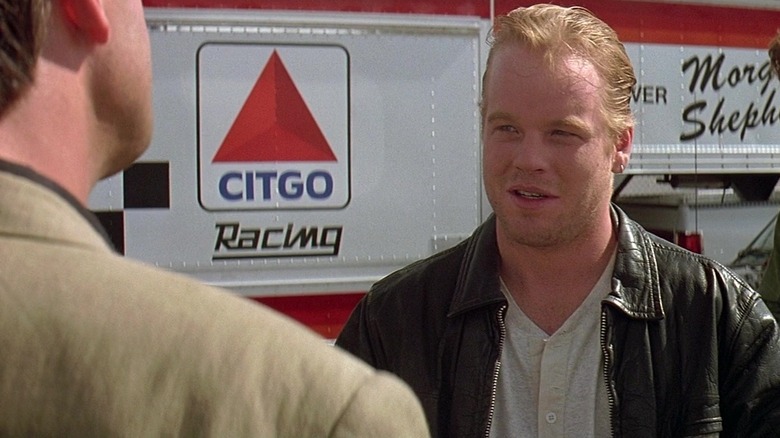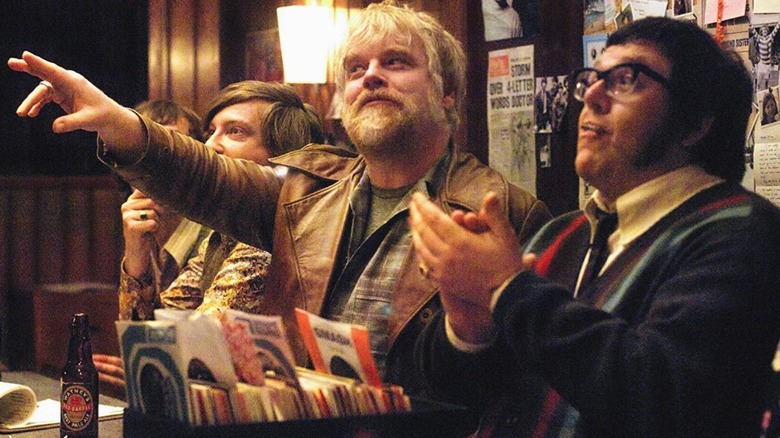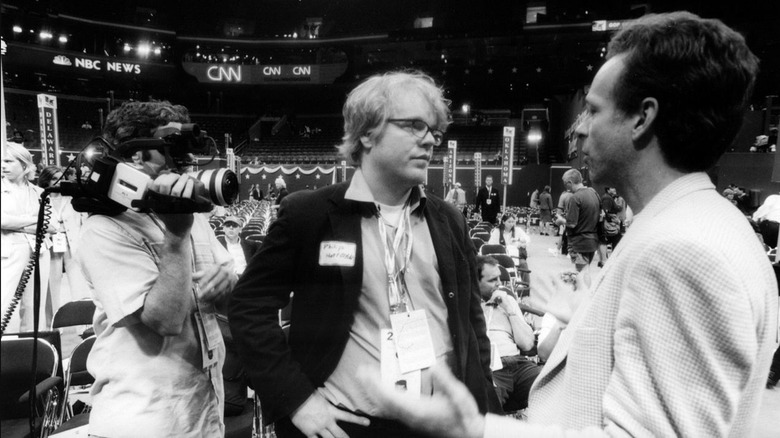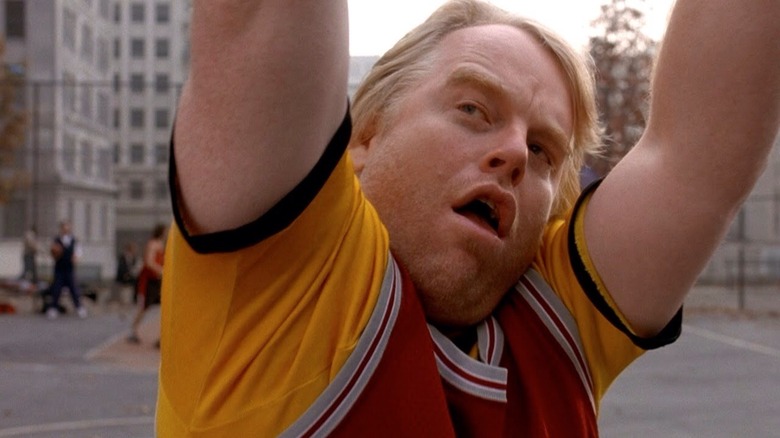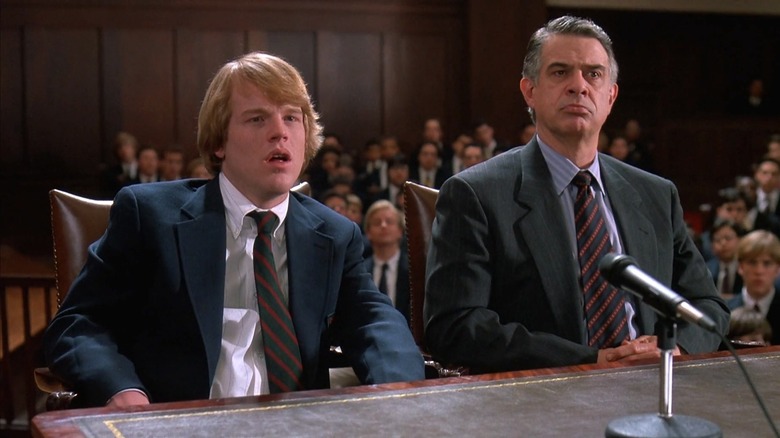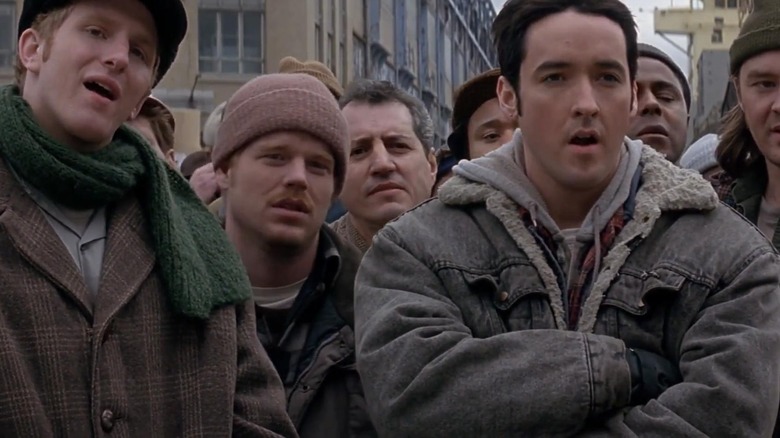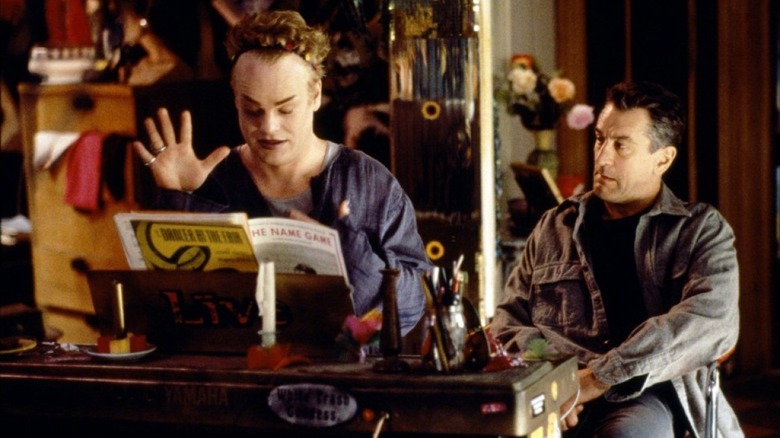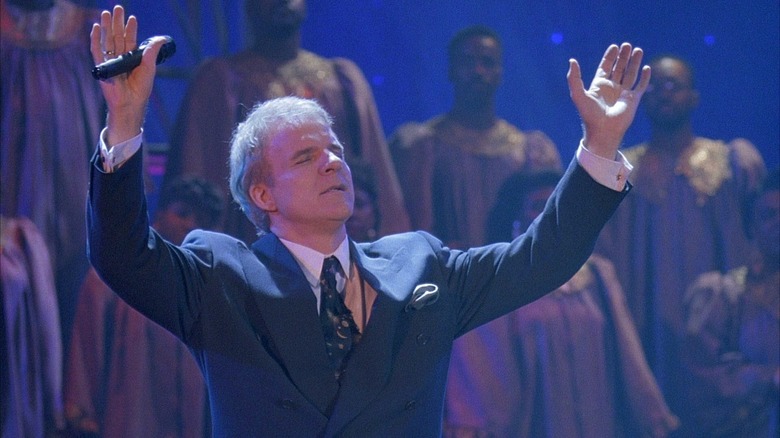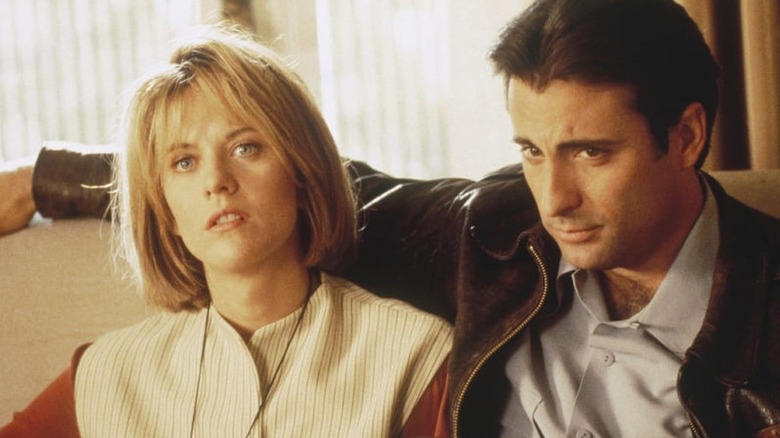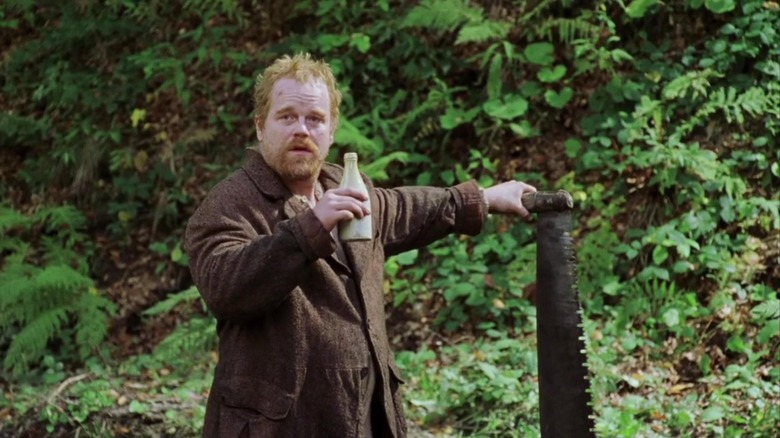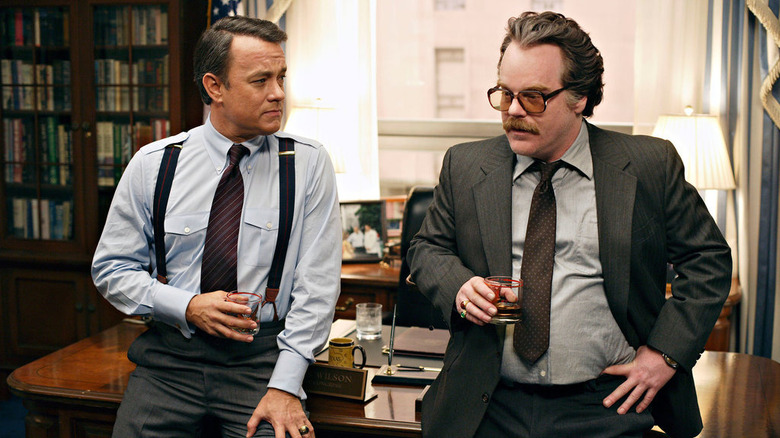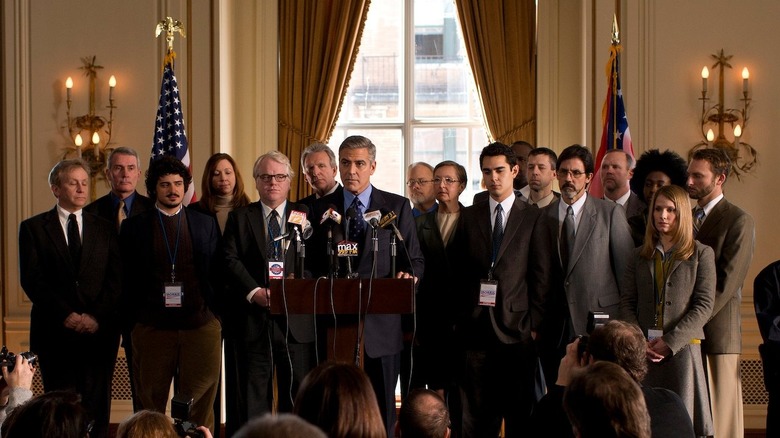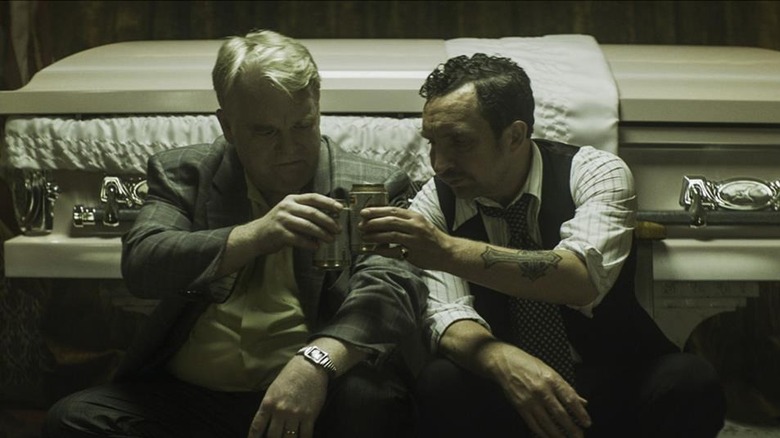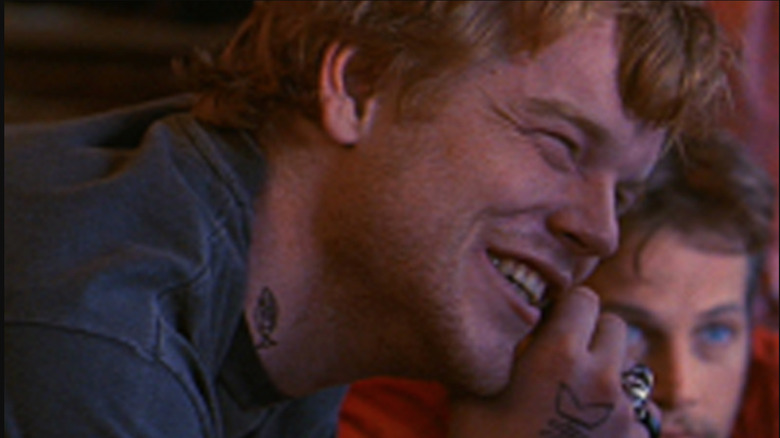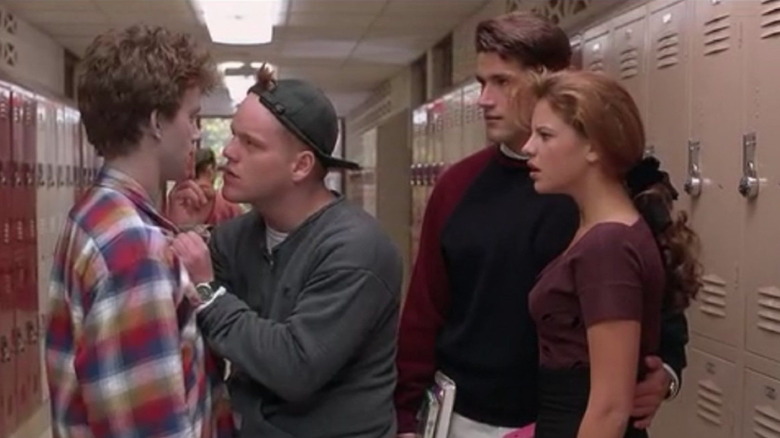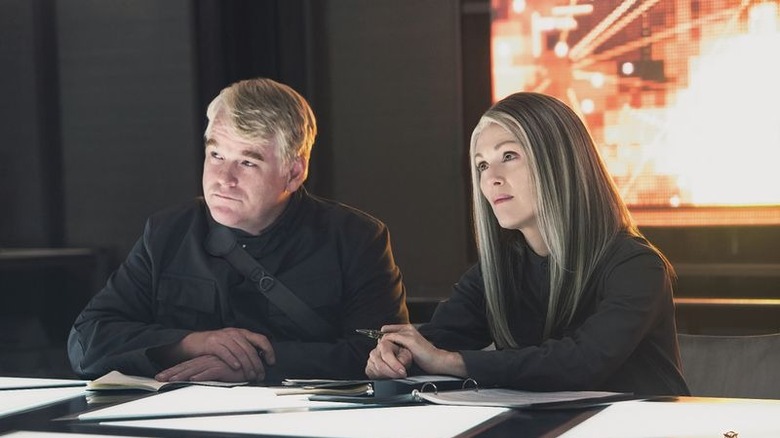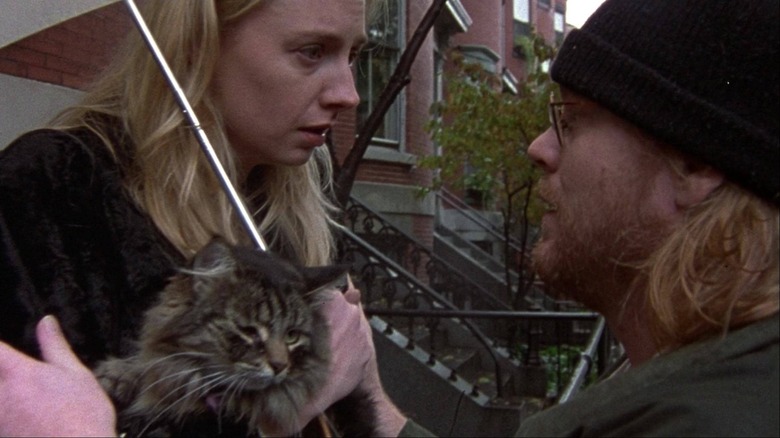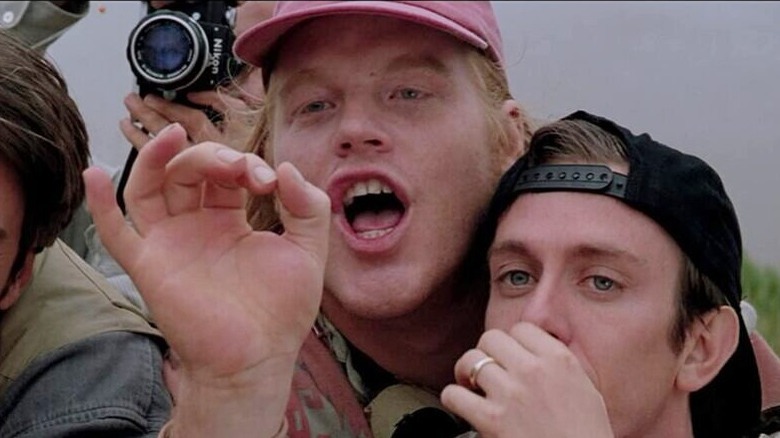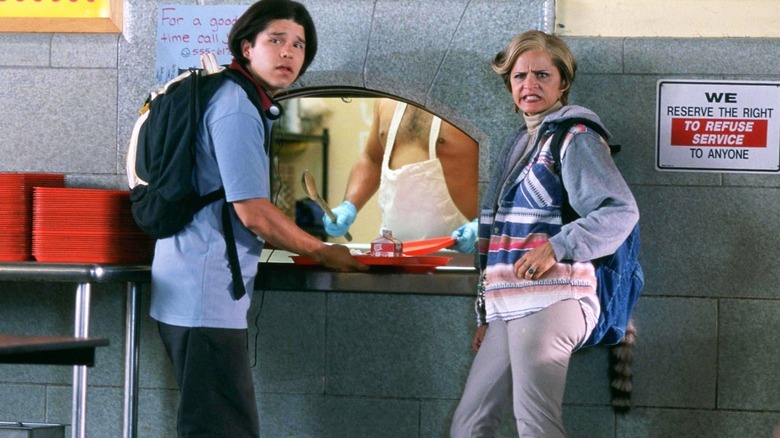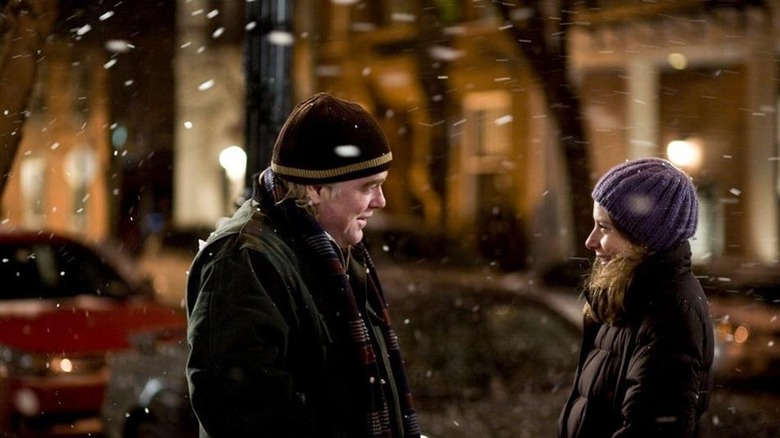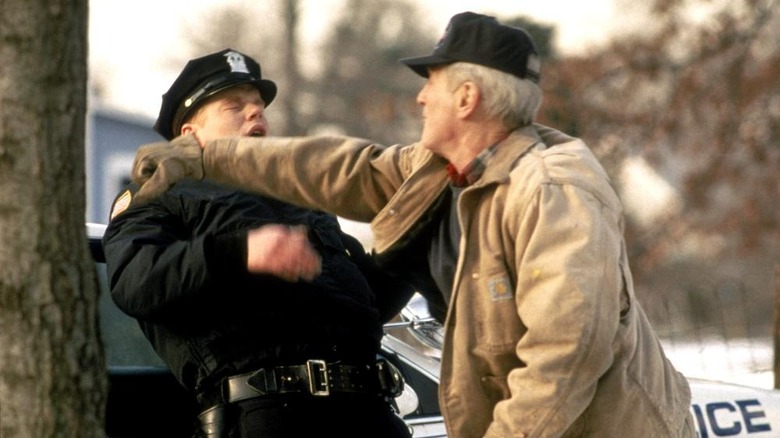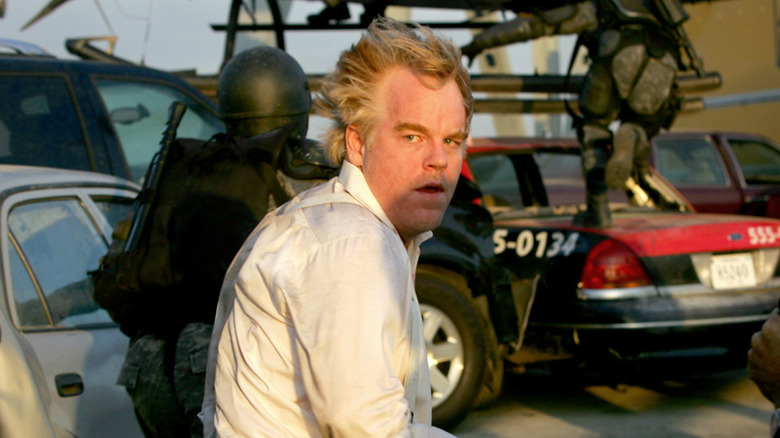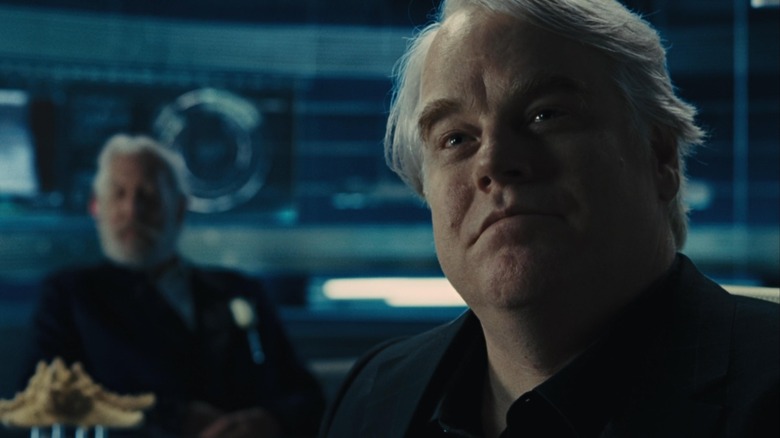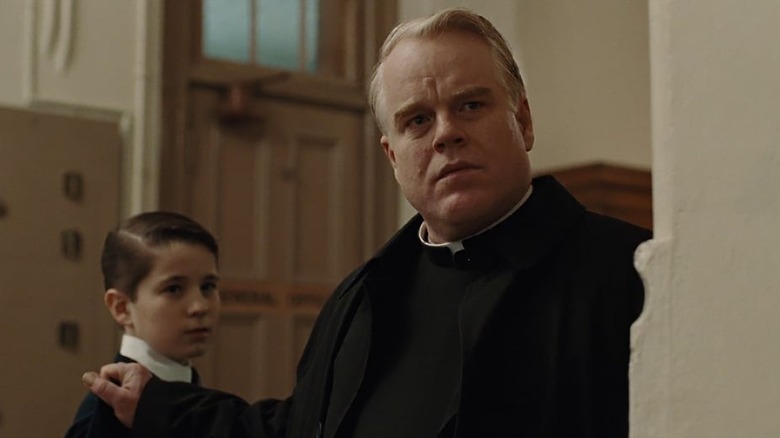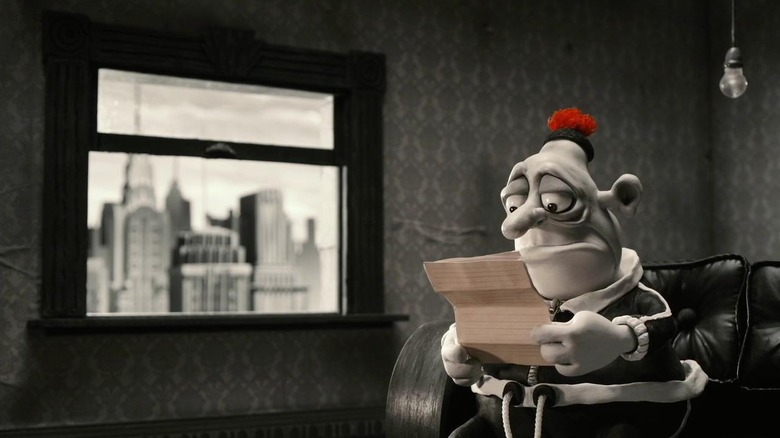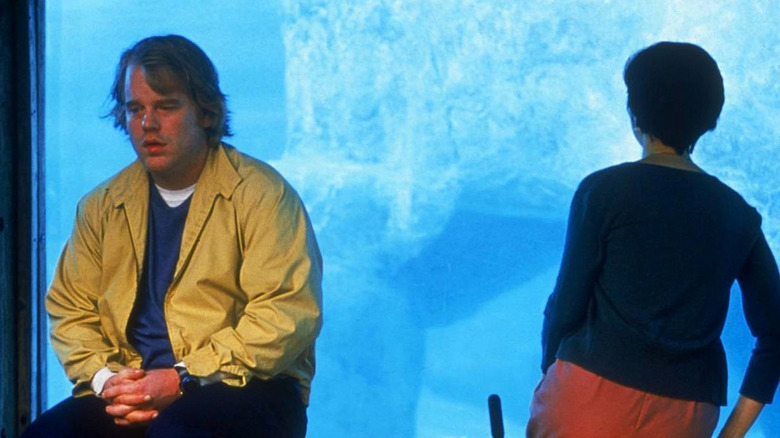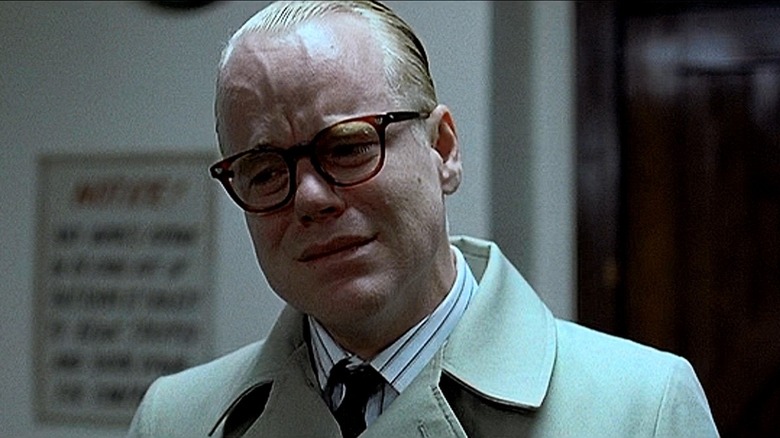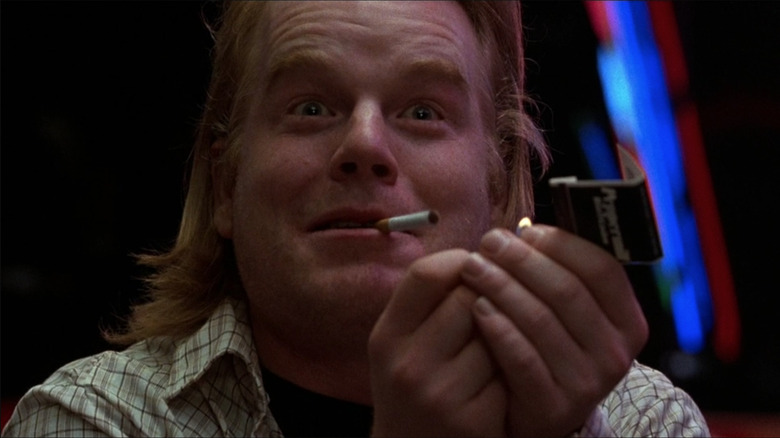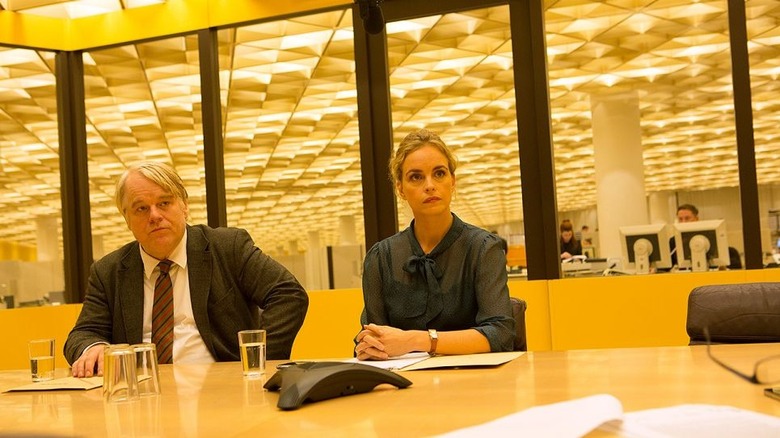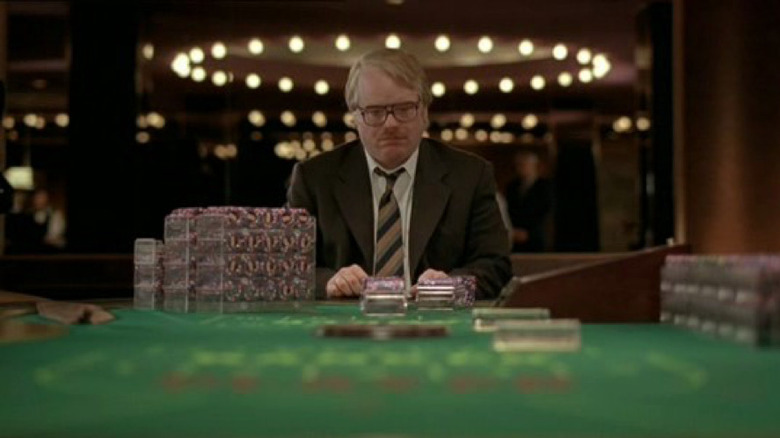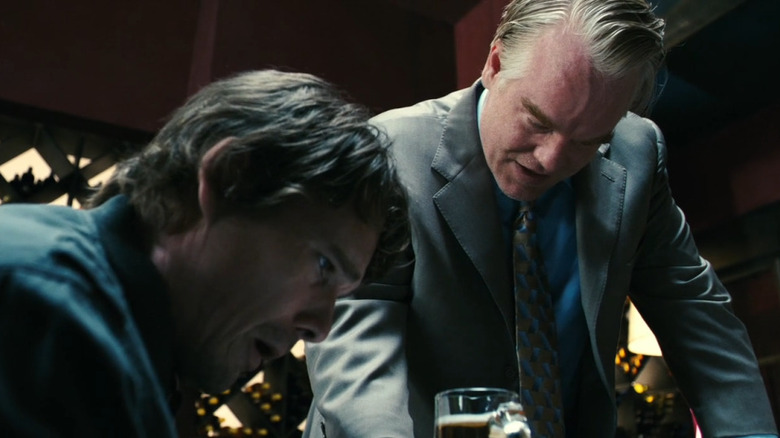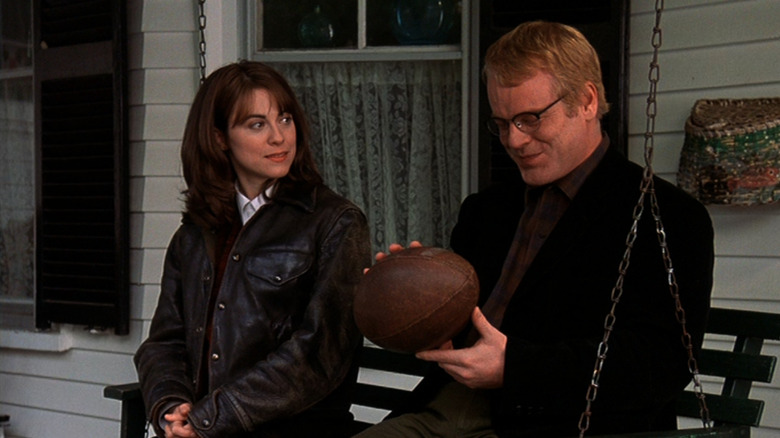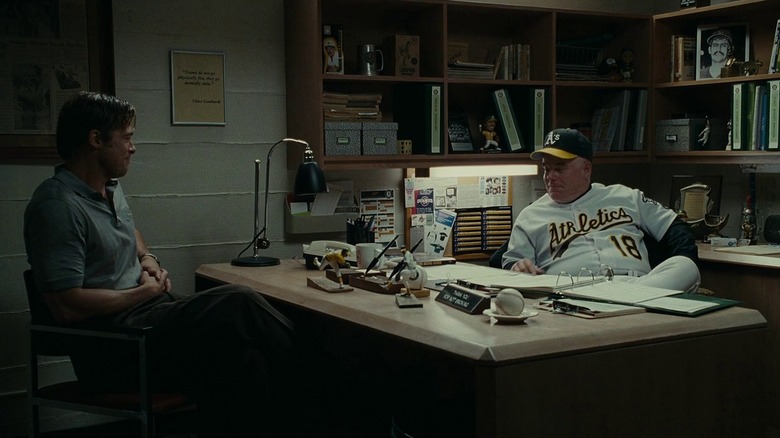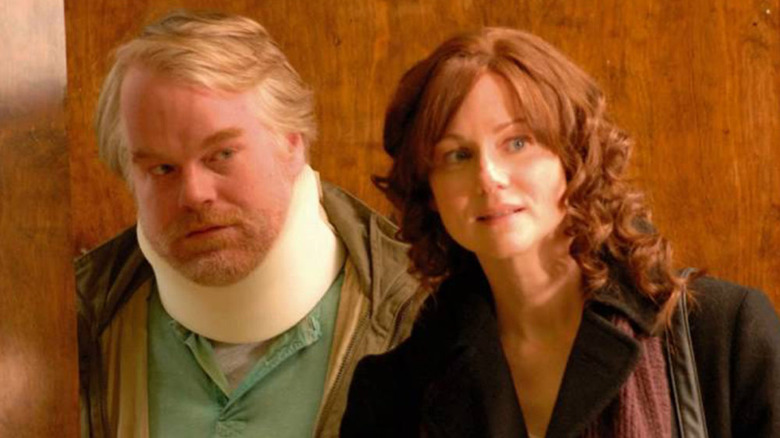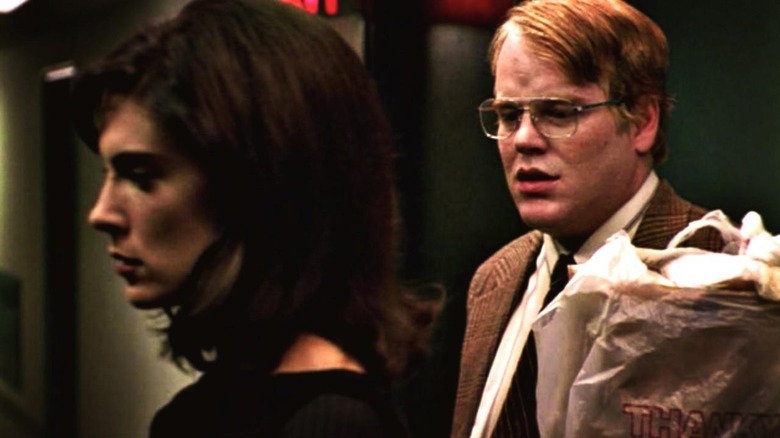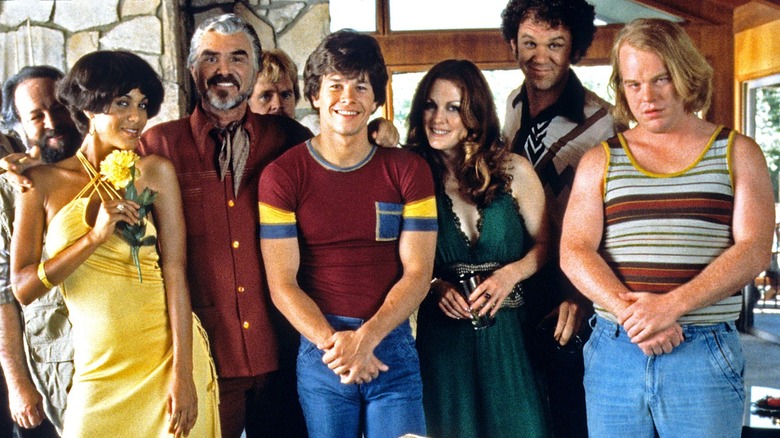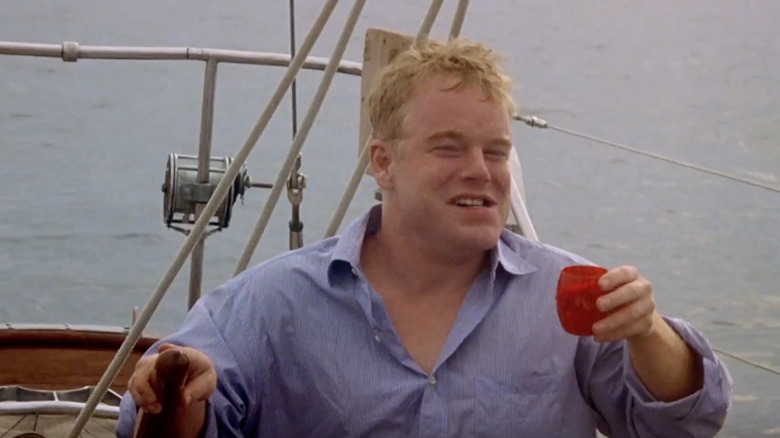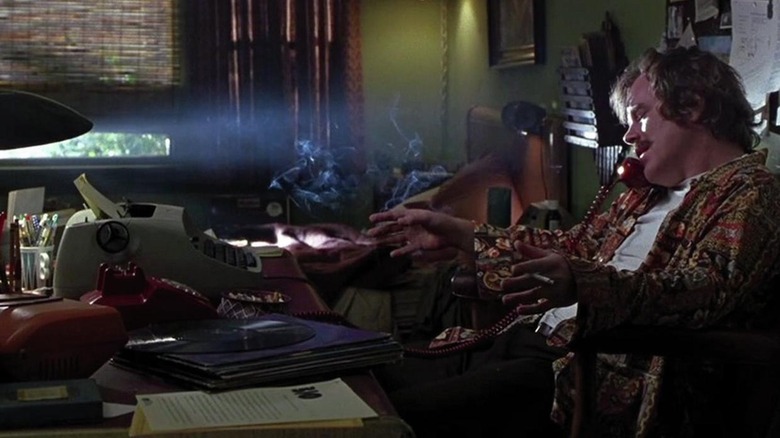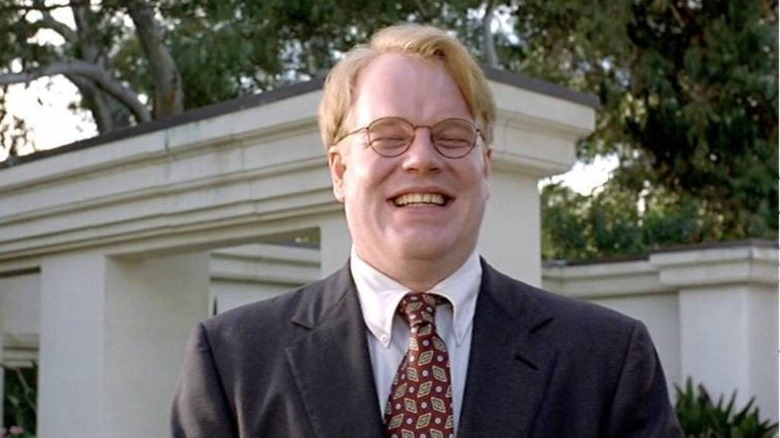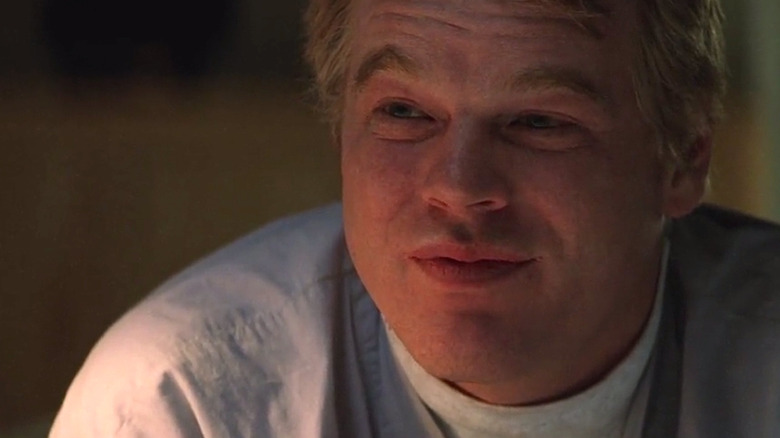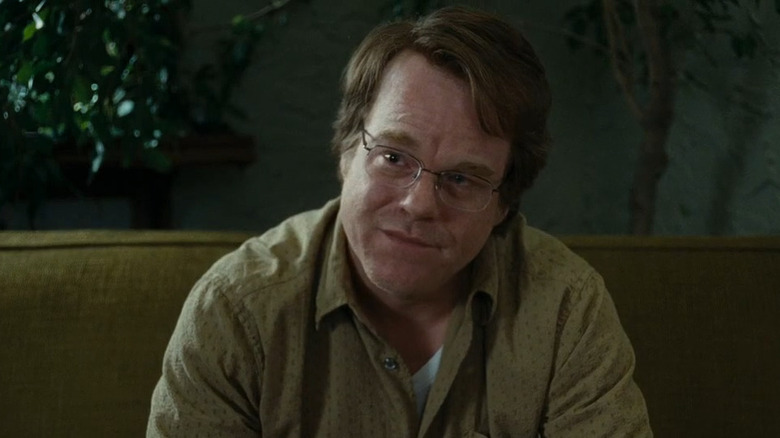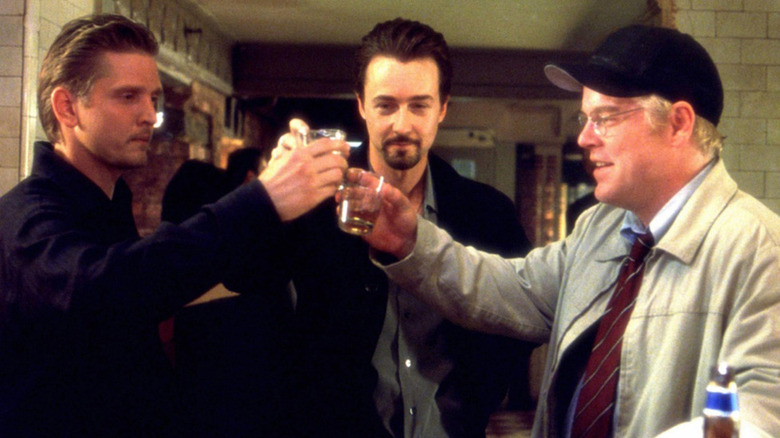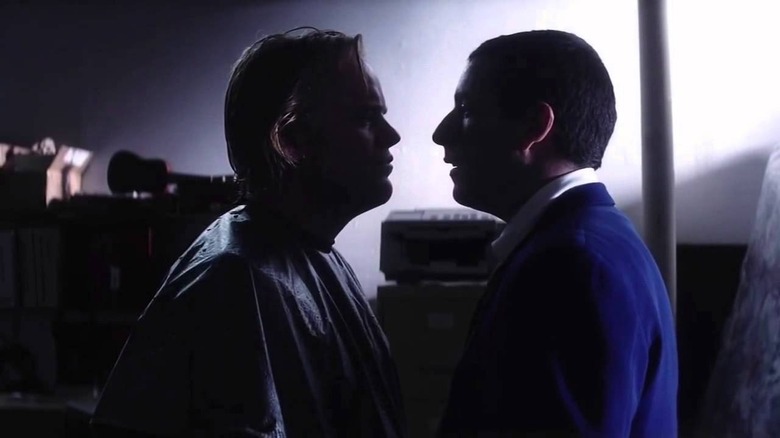Every Philip Seymour Hoffman Movie, Ranked From Worst To Best
When Philip Seymour Hoffman passed away in February 2014, he had been working as an actor for over 20 years and had made more than 50 films. But Hoffman was such a once-in-a-generation talent, equally skilled at silly comedy and harrowing drama and able to make even bad movies good for a little bit, that filmography doesn't seem nearly big enough. Hoffman's death robbed us of many more decades of great performances and collaborations with great filmmakers.
While Hoffman gave consistently great performances, the projects he chose didn't always live up to those performances, particularly early in his career. Some of those projects were so bad that even he couldn't save them — but just as many of his projects are modern classics. Here is all of Hoffman's work ranked from worst to best, starting with his low-budget early days and ending with his fruitful collaboration and friendship with Paul Thomas Anderson.
50-51. Triple Bogey on a Par Five Hole and Joey Breaker
Hoffman's earliest work is both hard to find and very inessential. "Triple Bogey on a Par Five Hole" (1991) is Hoffman's big screen debut and it later tried to capitalize on Hoffman's success by putting his name first on the poster. He's actually in very little of "Bogey," but what short screen time he does have makes far more of an impression than anything else in it, with its scant plot about criminals and professional golfers.
"Bogey" director Amos Poe would later produce one of Hoffman's most obscure movies, the 1993 comedy "Joey Breaker." Unlike "Bogey," even Hoffman's involvement hasn't been enough to make "Joey Breaker" widely available. It's not available on any streaming service, and it hasn't even been released on DVD. "Joey Breaker's" lack of availability is a sign of how little it has going for it, with its dated story of a talent agent learning to be slightly less racist and homophobic. Not even Hoffman makes much of an impression in it.
49. Montana
Hoffman is just one great actor among many wasted in the subpar 1998 crime drama "Montana," whose cast list also includes Kyra Sedgwick, Stanley Tucci, Robbie Coltrane, and John Ritter. Sedgwick plays a hit-woman on the run from the organization that hired her, a clichéd plot that the writers, director, and actors can't add any notes of originality to.
"Montana" came near the end of the wave of independent crime movies that started after the success of "Pulp Fiction," few of which could measure up to Tarantino no matter how hard they tried. "Montana" is one of the most forgettable entries in that wave, lacking any surprises or even an attempt at witty, Tarantino-esque dialogue. Hoffman tries his best to make "Montana" worthwhile, getting to play menacing as an accountant whose power-grabbing schemes set the plot in motion, but he's gone by the halfway point and the rest is just a slog.
48. Patch Adams
For the early part of his career, Hoffman was often the best part of movies that otherwise weren't worthy of his talents. The most glaring example of this is 1998s "Patch Adams," an awful movie that Hoffman singlehandedly makes good for one scene.
"Patch Adams" is mostly a showcase for some of the most unfunny and sappy material of Robin Williams' career, having him play a heavily fictionalized version of real-life doctor Patch Adams, who believed in making people laugh as much as healing them. Williams is on autopilot here, doing a worse version of his usual improv. Most characters in the movie find his antics hilarious, except for Hoffman as Patch Adams' unamused roommate. Hoffman's stone-faced reactions to Patch's jokes get bigger laughs than the jokes themselves.
But once Hoffman has finally had enough, he gets a scene as good as anything in his filmography where he lays into Patch for trivializing his very serious efforts to become a doctor. Hoffman's case against Patch is so convincing that even the movie making the Hoffman character eventually appreciate Patch does nothing to make his words seem any less true.
47. Red Dragon
The third and final film starring Anthony Hopkins as Hannibal Lecter, "Red Dragon" is also the second film adaptation of the "Red Dragon" novel. The first was "Manhunter" in 1986, which outshines the newer "Red Dragon" in every way. It's more tense than "Dragon," it looks better, and it has a much more interesting take on the main villain. "Dragon" attempts to make up for the quality difference by filling its cast top-to-bottom with heavyweight actors, but they can't do much for a movie this mediocre.
As is often the case, Philip Seymour Hoffman makes one of the better impressions of the cast, playing seedy tabloid reporter Freddy Lounds as an antisocial loser as opposed to Stephen Lang's more chatty and obnoxious take on the character in "Manhunter." But Hoffman isn't in "Dragon" that much and the other few strong performances in the cast can't overcome Edward Norton's awful lead performance as Will Graham, the FBI profiler played brilliantly by both William Petersen in "Manhunter" and Hugh Dancy in the "Hannibal" TV series. Compared to them, Norton doesn't even seem like he's trying, sleepwalking through the movie and not being remotely convincing as a genius investigator.
Hopkins by this point is far from the menacing charm of his initial Silence of the Lambs performance, but even he acts Norton off the screen in their scenes together.
46. The Getaway
A remake of the Sam Peckinpah movie of the same name, 1994s "The Getaway" replaces the original's Steve McQueen and Ali MacGraw with the then-married Alec Baldwin and Kim Basinger. Neither Baldwin nor Basinger have the charisma to match the original actors, and neither can Roger Donaldson hope to match Peckinpah's bleak, violent style. The end result isn't a disaster but a generic action movie, one that can't hope to compete with the movie that came before. But it at least offers some energy for the brief period that Hoffman is on screen before his character is brutally killed.
Hoffman played a lot of low-level criminals throughout his career, usually with some level of pathos, but his henchman in "The Getaway" is a rare instance of the actor just playing sleazy with no additional humanity. But even playing irredeemable in a bit part, Hoffman is still magnetic to watch, one of the few things in "Getaway" that could hold someone's attention.
45. Pirate Radio
"Pirate Radio," also known as "The Boat That Rocked," wants to be a celebration of rock music and nonconformity but only ends up a tired rehash of old clichés about the power of music. It can't even be bothered to accurately date the music it's supposed to be praising, having characters in 1966 talk about Jimi Hendrix and play 70s-era The Who. It's ultimately mediocre rather than bad on the strength of its cast, including Hoffman as a DJ running an illegal rock radio station off the shores of Great Britain.
His fellow DJs include Nick Frost, Rhys Ifans, and Bill Nighy, actors who are always fun to watch even when given subpar material. But even they can only do so much when the focus of the movie isn't on them. Instead, the main character is the bland teenager who hitches along with them, turning this into a pale imitation of much better coming-of-age comedies.
44. Last Party 2000
"The Last Party" was a 1993 documentary where Robert Downey Jr. recounted the events of the 1992 Presidential election. For the follow-up about the 2000 election, known as both "Last Party 2000" and "The Party's Over," Downey was replaced by Hoffman. The second "Party" is a surface-level documentary with not much insight on the political process or the two-party system, only worth watching for serious Hoffman completists.
Hoffman starts "Party" by saying that he made it because he was ashamed of his own political ignorance and wanted to learn more. He spends the rest of the documentary with that level of earnest curiosity, interviewing celebrities and politicians alike with simple questions and not much back-and-forth. It's charming to see Hoffman be so polite to his interviewees, but it doesn't make for a great documentary, especially when he never really questions the information he's given. The experience was valuable for Hoffman but it's not valuable to anyone watching it.
43. Along Came Polly
As his career went on, Hoffman became more known for heavy dramas than comedies, but he always delivered when he got to play silly. The funniest performance of his career is in "Along Came Polly," where he plays Ben Stiller's best friend as a slob with no sense of shame. A scene where Hoffman plays basketball and cannot make a single shot is a masterclass of both physical and verbal comedy, Hoffman's misplaced enthusiasm and complete lack of technique making every word and moment hilarious.
Almost all of the laughs in "Along Came Polly" come from either Hoffman or Alec Baldwin as Stiller's boss. Next to them, the main plot with Stiller romancing Jennifer Aniston is just bland, with nothing to distinguish it from any other romantic comedy. Stiller phones this in, doing a stock version of the nervous character he did better in "There's Something About Mary" and "Meet the Parents," while Aniston doesn't have any character to play beyond generic niceness. It's hard to care about whether they end up together or not — the only interesting business in the movie is happening to characters who aren't them.
42. Scent of a Woman
Philip Seymour Hoffman's first role in a studio film was in Martin Brest's "Scent of a Woman," where he played a rich college student hoping to buy his way out of punishment. The part is notable because it was the first time Hoffman's future collaborator Paul Thomas Anderson saw him in a movie, and Anderson would later recall that he "knew what love at first sight was" after seeing Hoffman for the first time.
Other than the appeal of seeing Hoffman play a contemptible snob, there's not much to enjoy in "Scent of a Woman." It's best remembered as the movie that finally won Al Pacino an Oscar but it's far from his best performance, living down to the complaints about his hammy delivery that have dogged him since the '80s. Watching Pacino go over-the-top playing a righteously angry blind man might have been enough to make "Scent" at least enjoyable, but the movie goes on for much too long, devoting two and a half hours to a story that cannot sustain that length.
41. Money for Nothing
Many of Philip Seymour Hoffman's early works are mediocre studio movies occasionally made better by Hoffman's presence. One such movie is the 1993 crime comedy "Money for Nothing," a forgettable John Cusack vehicle with some pretty good Hoffman moments. It's based on the true story of Joey Coyle, a longshoreman who discovered $1.2 million outside an armored van and decided to keep it, but little about the movie resembles the real events except the basic premise. Even for how many events are invented for the film, the filmmakers couldn't turn this story into a particularly interesting narrative, not finding much comedy or drama in Cusack's efforts to keep the money.
Hoffman makes an impression as a dock worker who attempts to muscle in on Cusack's money, and he's one of a few future stars existing in the margins of "Money for Nothing," alongside Benicio Del Toro and James Gandolfini. But a few fun performances can only get a movie so far when it doesn't have a strong enough story to tell.
40. Flawless
In the aftermath of "Batman & Robin," Joel Schumacher retreated from big-budget spectacle and made some smaller, more character-focused movies. One of those movies was 1999s "Flawless," where Hoffman plays a trans woman who develops a friendship with Robert De Niro's bigoted cop. It's a premise that needs a sensitive touch to not come off as offensive or condescending, and unfortunately Schumacher does not bring the necessary sensitivity.
"Flawless" is a collection of stereotypes and odd-couple clichés, tied together by a clumsy plot about runaway criminals targeting De Niro and building to the obvious conclusion of De Niro learning that queer people aren't so bad after all. "Flawless" would be even worse without the strong efforts of De Niro and especially Hoffman, who takes a potentially disastrous part and gives it humanity and specificity beyond what's on the page. He can't quite make "Flawless" any less misguided, but he does add some moments of sweetness to what's otherwise just a formulaic comedy.
39. Leap of Faith
Before Philip Seymour Hoffman got to play his own religious hoaxster in "The Master," he played backup to a sham preacher played by Steve Martin in the 1992 comedy "Leap of Faith." The early scenes of Martin orchestrating false miracles are the highlights of "Leap of Faith," playing well to Martin's strengths at playing phony show business figures and featuring the bulk of Hoffman's performance as a con artist thrilled to help Martin trick people. But Hoffman and the comedy eventually disappear from "Leap," leaving a sentimental movie about Martin learning that there are real miracles in the world.
The switch is disappointing because the first half offers not just laughs but some biting commentary on the charismatic preachers leaching money from their followers in the name of God. But the satire is abandoned in favor of Martin having a dramatic change of heart, effacing its initial message and leaving Martin stranded with nothing funny to do or say.
38. When a Man Loves a Woman
Another middling movie briefly given life by Hoffman is the 1994 romantic drama "When a Man Loves a Woman." It's a well-intentioned movie, taking a serious look at alcoholism through both an alcoholic played by Meg Ryan and her husband played by Andy Garcia, and Ryan especially is very good in the part. But the movie is hampered by a slow pace and sentimentality that's at odds with its more complicated view of addiction and enabling.
"When a Man Loves a Woman" wants to be a hard look at a marriage brought to the brink by alcoholism, but it keeps falling back on the tone, glowing look, and clichés of an ordinary studio romance. Even Philip Seymour Hoffman's character is another example of the film's use of tropes: a recovering alcoholic who exists only to romance Ryan and make Garcia jealous. But despite the character's tired role in the plot, Hoffman still gives him surprising personality, with confidence and empathy to Ryan's struggles rather than just being an obstacle.
37. Cold Mountain
Anthony Minghella's Civil War epic "Cold Mountain" is overloaded with small parts for famous actors and celebrities — some good and some distracting. Hoffman makes one of the best impressions, playing an amoral preacher who briefly tags along with Jude Law's character. His gleeful depravity is a welcome bit of levity in a movie that can be very grim, but he's gone soon after he arrives.
The rest of "Cold Mountain" is gorgeous but emotionally inert, following great actors across beautiful landscapes as they act out a thin romantic plot. Nicole Kidman and Jude Law don't get much time together before they're separated by war and their bond isn't convincing enough to withstand the movie's two and a half hours. Kidman spends much of the film with Renée Zellweger, whose Oscar-winning performance is hammy but more interesting than the rest of the movie's self-seriousness. Zellweger and Hoffman are acting in the ideal version of "Cold Mountain" while most of the other performers are struggling.
36. Charlie Wilson's War
"Charlie Wilson's War" boasts an impressive cast and crew, with Hoffman, Tom Hanks, and Julia Roberts starring, Aaron Sorkin writing, and Oscar-winner Mike Nichols directing. But all that talent couldn't make the true story of Charlie Wilson, a Congressman who financed the anti-Soviet efforts in 1980s Afghanistan, play better than mildly interesting on-screen. "Charlie Wilson" is amusing and breezy but should be much more, especially considering the rich political context surrounding the story. Nichols never made another movie between "Wilson" and his death in 2014 — and "Wilson" is a lightweight finish to a great career.
Philip Seymour Hoffman is a highlight of the movie, playing the ornery CIA operative who teams up with Charlie Wilson on his mission. Hoffman received the movie's only Oscar nomination, and he gets the most memorable scene in it, where he chews out an unresponsive CIA director played by John Slattery and then destroys his office. In this scene, Hoffman stands out from the rest of the movie for his passionate anger, a rare bit of raw emotion in a film that's relaxed to a fault.
35. The Ides of March
Like "Charlie Wilson," "The Ides of March" is a decent, well-acted drama that should be much more given the caliber of its cast and creative team. George Clooney directed, wrote, and starred opposite Hoffman, Ryan Gosling, Paul Giamatti, and Evan Rachel Wood — but the movie coasts off their charisma rather than actually going deeper with its critique of the political system. While it's fun to watch Hoffman go toe-to-toe with Giamatti as rival campaign managers, even their sparring doesn't make the impact it would in a more insightful movie.
The premise of "Ides" is that a seemingly idealistic politician might turn out to not be so honest, a familiar plot that Clooney doesn't add many interesting specifics to. And the main character, Gosling as the Clooney character's press secretary, is so vaguely-written that it's hard to care whether he switches campaigns or quits politics altogether. Any drama in "Ides" is provided by Gosling's strong chemistry with Wood as a fellow worker for Clooney's campaign — they deserve to be together in a good romance rather than a toothless political drama.
34. A Late Quartet
The promise of Philip Seymour Hoffman working opposite Christopher Walken suggests a lot of big acting, but the two men's only collaboration — the 2012 drama "A Late Quartet" — offers much subtler performances than that. Walken especially tones down his usual tics and mannerisms to play a renowned cellist diagnosed with Parkinson's disease, reacting to his illness by retreating inside himself and away from his friends and colleagues. Hoffman follows Walken's lead by underplaying as the second violinist in Walken's string quartet, politely waiting for his turn to get the first violinist chair and learning that he may never get the opportunity.
"A Late Quartet" can occasionally be melodramatic, particularly a plot where the quartet's first violinist has an affair with Hoffman's daughter, but its performances are strong enough and its classical-music world setting is interesting enough that its flaws are easy to forgive. It's especially worthwhile to see Hoffman at his most restrained, conveying deep hurt while seeming to do very little on the surface.
33. God's Pocket
Hoffman had two movies premiere at the Sundance Film Festival the month before his death. The worse-received of the two was "God's Pocket," the directorial debut of John Slattery. Slattery attracted a top-notch cast, including Hoffman, fellow "Mad Men" star Christina Hendricks, John Turturro, and Richard Jenkins, to this story about a small Philadelphia neighborhood rocked by a violent death. The actors do what they can but they can't quite make "God's Pocket" live up to its potential.
"God's Pocket" exists in the shadow of many other crime movies and it doesn't make a strong enough case for what sets it apart, offering no surprises in either plot or character. The large number of former Coen brothers actors in the cast, including Hoffman, makes it hard to not compare "Pocket" to the Coens' movies about incompetent criminals and low-level schemers — and it comes up short in comparison. It's especially deficient in how it manages its different tones, with Slattery not being able to come close to the Coens' mixture of comedy and bleak violence. It's still watchable mostly because of its cast, but it should aspire to much more than that.
32. My New Gun
Philip Seymour Hoffman is only in one scene of the 1992 dark comedy "My New Gun," but the impression he makes off that scene lasts far beyond his literal screen time. He plays a fast-food restaurant employee who suddenly, while on the job, launches into a monologue about thunderstorms and a period in high school when he used to vomit blood. Hoffman's character is never seen again, and only mentioned when it's said later that he was shot off-screen, but in very little time, he creates a bizarre, memorable character.
While much of Hoffman's early work sees him trying his best within movies that don't work otherwise, "My New Gun" stands apart from those movies by being pretty good on its own merits. It's a quirky comedy starring Diane Lane as a housewife gifted a gun by her husband, a gun that's then stolen by their neighbor Skippy (James Le Gros). Much like Hoffman's performance, it's funny in unexpected ways, getting laughs from careful camera positions and dry line readings rather than outright jokes. It's not for everybody, but fans of deadpan comedy should find a lot to enjoy.
31. My Boyfriend's Back
For all of Hoffman's talents at playing complicated, flawed people, he could also do just as well playing jerks and bullies. One such bully is his character in "My Boyfriend's Back," a horror-comedy where he plays the dim-witted sidekick to a jock played by Matthew Fox. Here, Hoffman's gift for physicality allows him to adopt a perpetually slouched, open-mouthed stance, looking more like a zombie than the actual zombie who shows up in the story.
Generally Hoffman fits humanity into even his most unlikable characters, but here he plays nothing but an empty-headed menace. He's one of the best parts of "My Boyfriend's Back," but the movie as a whole is surprisingly clever, a zombie movie where nobody is bothered by the appearance of zombies. It struggles to balance its deadpan comic tone with the serious romantic plot at its center by the end, but it's funny and unique enough to paper over some of its flaws.
29-30. The Hunger Games: Mockingjay Parts 1 and 2
At the time of his death, Hoffman was working on the final two installments of the "Hunger Games" franchise, where he played Plutarch Heavensbee, a leader of the rebellion against the franchise's evil President Snow. He finished "Mockingjay Part 1" but died before completing the second part, which was released almost two years after his death.
Both parts of "Mockingjay" are ultimately hampered by the decision to split one book into two movies, leaving "Part 1" as a two-hour prelude to the action and "Part 2" as all the action. This leaves both movies with different strengths and weaknesses, but "Part 1" may be slightly better just for how it gives Hoffman more to do. In the middle of an otherwise grim franchise, he even gets to be funny, playing comic frustration at Jennifer Lawrence's Katniss, over her inability to convincingly play the hero of the revolution for propaganda spots.
Hoffman gets much less screen time in "Part 2," in part due to him not finishing his scenes but also because the movie sidelines many of its supporting characters in favor of more action. That means it's often more exciting than its predecessor while also lacking the pleasures of seeing the franchise's best actors interact with each other.
28. Next Stop Wonderland
Hoffman is only in two scenes of "Next Stop Wonderland," but he makes such a big impression that he ends up overshadowing the rest of the movie. He opens the movie as the boyfriend of Hope Davis's protagonist, a self-righteous activist who makes Davis read a list of the reasons he's breaking up with her before he leaves her. He's both hilarious and convincing as the most irritating boyfriend imaginable, so much so that when he comes back at the end of the movie with a seemingly better attitude, it's still hard to want Davis to get back together with him.
The parts of "Next Stop Wonderland" between Hoffman's appearances are a solid romantic comedy, with Davis dodging several potential suitors after her mother posts a singles ad for her without her knowledge. Davis is a very charming lead and her suitors are funny, especially voice actor H. Jon Benjamin in a rare on-camera appearance. But the movie's never quite as funny as when Hoffman is first on-screen — nobody can live up to his masterful comedic abilities.
27. Twister
With the knowledge of what a dramatic powerhouse Philip Seymour Hoffman became after "Twister" in 1996, it now seems bizarre that he was a comic-relief side character in a special effects-driven blockbuster. Even compared to Hoffman's other comedy performances, there isn't much to his performance in "Twister," where he plays a goofy slob excited by tornados. He's amusing but not much more, the rare instance where any character actor could replace him and do the same thing equally well.
"Twister" itself is not a top-tier blockbuster of its era. It was sold at the time on the realism of its tornado effects, but its CGI has aged worse than fellow digital effects landmarks "Jurassic Park" and "Terminator 2." Those movies also offered much stronger characters than "Twister," with leads Bill Paxton and Helen Hunt making significantly less of an impression than the tornados they're running from. But despite its flaws, "Twister" is still a good time, with director Jan De Bont creating fun setpieces and bringing some of the relentless energy he mastered when making "Speed" two years before.
26. Strangers With Candy
"Strangers with Candy" is a film adaptation of the Comedy Central show of the same name, following Amy Sedaris as 46-year-old high schooler Jerri Blank. The transition to feature-length for the "Strangers" writing team, including Sedaris, director Paul Dinello, and Stephen Colbert, is not seamless, and what was funny in 30-minute episodes doesn't quite make the same impact over 97 minutes. But there are still plenty of laughs, including many just from Philip Seymour Hoffman's brief performance.
Hoffman is one of a few celebrity cameos in "Strangers with Candy," including Matthew Broderick and Sarah Jessica Parker, but none of the others commit to their roles as strongly as Hoffman does. He plays a science fair judge with rage issues, and he's funny specifically because he plays the part like he's in a heavy drama even when he's saying funny things. His angry outbursts stand in such sharp contrast to the rest of the movie's cartoon tone that they're genuinely shocking in addition to hilarious.
25. Jack Goes Boating
In 2010, Hoffman made his directorial debut with "Jack Goes Boating," adapted from the play of the same name which Hoffman starred in an off-Broadway production of. Hoffman was planning on directing another film at the time of his death and on the merits of "Jack Goes Boating," he could have very likely developed a strong side career as a director.
Hoffman doesn't offer any technical flash or moments of bravura acting in "Boating," he instead tells a simple story in a simple way and lets the actors, including himself in the lead role, do much of the heavy lifting. The result is a sturdy romantic drama between Hoffman and Amy Ryan, playing two ordinary, charming people falling in love while their friends' (John Ortiz and Daphne Rubin-Vega) own relationship falls apart. There's not much more to "Jack Goes Boating," but there doesn't need to be when the performances are this strong and the writing is this naturalistic.
24. Nobody's Fool
Even in his earliest films, Philip Seymour Hoffman held his own against some of the best actors of all time. One such actor was Paul Newman, who played opposite Hoffman in the 1994 dramedy "Nobody's Fool." Hoffman doesn't get a standout part in "Fool," playing a stuck-up cop who keeps finding reasons to write Newman up, but he has a good back-and-forth with Newman and gets to play the straight man to Newman's sarcastic old man.
There's not much of a plot to "Nobody's Fool," just Newman's character gradually learning to be a little more mature and be a better man for his family. Mostly director Robert Benton just sits back and watches Newman behave, which is more than enough to sustain a movie when it has an actor with as much charisma as Newman. It's wonderful to watch Newman play cranky and it's even a little moving to see him finally take responsibility for himself by the end.
23. Mission: Impossible III
Hoffman's first role after his Oscar win was the villain part in "Mission: Impossible III," which allowed him to play a more frightening role than he ever had on-screen. The "Mission: Impossible" movies are generally associated with Tom Cruise more than any individual villain, but "III" is an exception, where it becomes a real possibility that Cruise might not be able to defeat someone as evil as Hoffman. The movie's first scene is its best scene, where Cruise seems uncharacteristically fragile next to Hoffman screaming orders at him.
Hoffman is much more prominent in the first half of "III" than he is in the second half, and the movie starts to falter once he's not in it as much. The conspiracy surrounding Hoffman's villain isn't nearly as interesting as Hoffman himself, and the movie's cutesy treatment of its central subject, an unknown weapon called the "Rabbit's Foot," is grating. Plus it has some of the weakest spectacle of the "Mission: Impossible" franchise, with all three subsequent movies having much better setpieces. But it's still generally fun, and the franchise has never been as terrifying as Philip Seymour Hoffman's big scenes in this.
22. The Hunger Games: Catching Fire
Hoffman doesn't do much in "The Hunger Games: Catching Fire" — his character's presence is mostly set-up for the more active role he takes in the "Mockingjay" movies. But his addition to "Catching Fire" is still a welcome change in a movie that makes almost nothing but welcome changes to the formula of its predecessor.
"Catching Fire" improves on the first "Hunger Games" most dramatically with its action, ditching the frantic handheld photography that made the first one's setpieces hard to see in favor of steadier shots. But beyond just looking better than "The Hunger Games," it's also a more incisive movie than its predecessor — its first half especially offering the franchise's sharpest satire as it follows a traumatized Katniss being paraded around as a hero for the victory of not dying. There's not much action until late in "Catching Fire" but that doesn't matter when the drama with Katniss struggling to readjust to her previous life is this fascinating and this well-acted by Jennifer Lawrence.
21. Doubt
John Patrick Shanley's "Doubt" is based on Shanley's play of the same name and it makes no effort to disguise its stage origins, it is simply 100 minutes of people talking to each other. Luckily, the people talking were some of the best actors working in 2008, and "Doubt" succeeds on the back of their performances, with all four of its leads getting Oscar nominations. Philip Seymour Hoffman fares especially well, playing the charismatic priest who Meryl Streep's stern, judgmental nun believes could be abusing an altar boy.
Hoffman plays the priest with a genial nature that could just as easily be genuine as it could be a front for something much darker. A fiery sermon he gives on the subject of "gossip" hints at an anger he otherwise doesn't allow himself to show. But even Streep, Hoffman, and Amy Adams end up secondary to Viola Davis's heartbreaking performance as the mother of the altar boy — she's only in one scene but the strength of her anguish in that scene completely changes the rest of the movie.
20. Mary and Max
Hoffman's only animated credit is the stop-motion feature "Mary and Max," which uses its hand-crafted style to tell a sad but ultimately touching story about making connections. Hoffman voices Max, an overweight New Yorker with Asperger syndrome who begins a pen-pal relationship with a young Australian girl named Mary. Their correspondence can be funny but more often it's bittersweet, Mary and Max bonding over the factors that have made them outcasts even to their own families.
"Mary and Max" goes to some dark places, showing its characters in the grips of suicidal depression that their correspondence may not be able to solve, but the movie always returns to the strength of the bond they've made with each other, the commonalities they've found and the little ways they've improved each other's lives. Even for all the grim events that occur in "Mary and Max," it's a movie ultimately about the healing power of friendship, where even the two most unexpected people could change each other's lives.
19. Love Liza
It took until 2002 for a director to give Philip Seymour Hoffman the lead role in a movie. That movie was "Love Liza," starring Hoffman as a widower struggling to move on with his life after his wife's death. "Love Liza" is a frequently depressing movie, especially as Hoffman's character takes to inhaling gas fumes to deal with his grief, but the strength of Hoffman's performance, and his fearlessness in playing grim emotional states, keeps this from being a slog.
"Love Liza" was marketed as a "comic tragedy," and while that may overstate the amount of humor in it, it does have a slight sense of humor to offset how depressing the story is. Hoffman takes to flying model airplanes as an escape from grief and his overenthusiasm about this hobby is both funny and sweet. But even amusing moments can quickly curdle into something gut-wrenching, like a scene where Hoffman alienates his only friend by refusing to stop talking. It can be a tough sit but its merits are strong enough to be worth the trouble.
18. Capote
Hoffman's only Oscar win came as a result of playing famed author Truman Capote in Bennett Miller's "Capote," a biopic about the author's experiences writing "In Cold Blood." "Capote" has a strong supporting cast, including an Oscar-nominated Catherine Keener as Capote's childhood friend Harper Lee, and Miller beautifully films it in muted greys, befitting a sad story haunted by murder. But as the title suggests, everything else in the movie is secondary to Hoffman as Capote.
Philip Seymour Hoffman's imitation of Capote's legendary high-pitched voice is spot-on, but more impressive is how Hoffman disappears into the part beyond just looking and sounding like Capote. While many actors in biopics try and fail to disguise themselves with prosthetics, it becomes hard to see Hoffman in the part rather than Capote not because he transforms physically, but because he gives such a convincing, understated performance. Even Hoffman's other great performances don't make his work as invisible as it is here.
17. Hard Eight
1996s "Hard Eight" was the directorial debut of Paul Thomas Anderson and the beginning of Anderson's five-film collaboration with Philip Seymour Hoffman. Hoffman would get bigger roles in later Anderson films but his one scene in "Hard Eight" is still one of the actor's high water marks.
Hoffman enters "Hard Eight" at the halfway point, playing a loudmouth gambler antagonizing Philip Baker Hall's older and much more reserved gambler. Up to this point, "Hard Eight" had mostly been a quiet character drama, with Hall intervening in the lives of two lost souls stuck in Reno. But Hoffman's trash talk and furious energy breaks the quiet of what came before and even catches the cool and collected Hall off-guard. His scene is a transition point to the much darker second half of "Hard Eight," where the previously unflappable Hall starts to crumble in reaction to a botched kidnapping — but even on its own it's a magnificent scene, showing that Anderson knew how to play to Hoffman's strengths even the very first time they met.
16. A Most Wanted Man
Philip Seymour Hoffman's final starring role, "A Most Wanted Man" would be a bleak watch even without Hoffman's death hanging over it. Adapted from the novel by "Tinker Tailor Soldier Spy" author John Le Carré, "A Most Wanted Man" makes spying seem as mundane and depressing as it is dangerous. The depiction of espionage is even less glamorous than in "Tinker Tailor," tired-looking people in dirty rooms and vans waiting for something to happen. Hoffman plays the senior member of the spy team and he looks especially beaten-down, like years of this job have sapped him of his spirit.
"A Most Wanted Man" is a slow burn for much of its runtime but the viewer's patience is rewarded by its devastating ending, where all of Hoffman's efforts to protect a potential informant prove to be in vain for reasons he couldn't control. Hoffman's despair at the end is one of his great acting moments, the burden of his job finally collapsing in on him.
15. Owning Mahowny
Even with as beloved as Hoffman still is, one of his very best performances still remains largely unseen. That performance is in 2003s "Owning Mahowny," based on the true story of a Canadian bank employee who embezzled millions from his company to sustain his gambling addiction. It's a fascinating movie with a brilliant performance at its center, one of Hoffman's smallest and most enthralling.
Rather than lean into the character's criminal behavior, Hoffman plays him as reserved and bland from beginning to end, never seeming excited by his victories or bothered by his losses. The most he does when reacting to a win is push his glasses up his nose. Mahowny is an enigma whose underlying motivations are never figured out, and that makes him more interesting than if the movie, or Hoffman, tried to explain what made him this way. His blankness is all the explanation needed to show how Mahowny impressed and baffled casino bosses and employees — they believed he had a masterful poker face when he was just naturally that resistant to emotion.
14. Before the Devil Knows You're Dead
The final film of legendary director Sidney Lumet, made 50 years into his career, "Before the Devil Knows You're Dead" is as aggressive as the gritty crime dramas Lumet made his name on in the 70s. "Devil" may go even further than "Serpico" or "Dog Day Afternoon," with its horrifying portrayal of a family broken apart by greed and distrust.
Philip Seymour Hoffman plays the would-be mastermind of a scheme to rob his own parents' jewelry store, a plan that quickly and violently backfires and is further sent astray by Ethan Hawke as Hoffman's screw-up brother. Hawke may cause the trouble but Hoffman is just as much the problem, believing he can control events he's in reality much too powerless to contain. Neither Hoffman nor Hawke's characters are as smart as they think they are and that gets them into big trouble, eventually leading to both men's destruction.
"Before the Devil Knows You're Dead" can be a hard movie to watch, especially the scenes with Hoffman bullying Hawke into executing his doomed schemes — but it's ultimately rewarding for Hoffman and Hawke's excellent performances and Lumet's unshowy direction, letting the story's tragedy speak for itself rather than emphasizing it with flashy camerawork.
13. State and Main
Hoffman rarely got to play a romantic lead on film, which makes his sweet performance in David Mamet's wonderful comedy "State and Main" all the more special. He plays the screenwriter of the central movie-within-a-movie, which takes over a small New England town and annoys many of the residents, including a bookseller played by Rebecca Pidgeon who Hoffman falls for.
Hoffman and Pidgeon are just one part of an ensemble full of talented actors, including frequent Mamet collaborators William H. Macy, Alec Baldwin, Ricky Jay, and Clark Gregg. It's no surprise that those actors do well with Mamet's famously dense, witty dialogue, but despite being a newcomer to the Mamet style, Philip Seymour Hoffman shines just as well as any of his co-stars. Mamet's dialogue is sometimes criticized for sounding unnatural but Hoffman delivers it beautifully, selling the punchlines but never at the expense of playing a real, awkward human being. Plus, he and Pidgeon have real chemistry together, creating an offbeat but lovable couple that gives "State and Main" an emotional core as strong as its laughs.
12. Moneyball
Hoffman didn't always steal the show in his movies, sometimes he knew the best way to act was to do a solid, unshowy job while others get the flashier roles. This is the case with "Moneyball," where Hoffman is very good as uncooperative Oakland Athletics manager Art Howe but mostly takes a backseat to Brad Pitt giving one of his greatest performances to date as sabermetrics pioneer Billy Beane. Pitt brings such powerful movie-star charm to the part that it's pointless to try to equal him, so Hoffman wisely stays in the background while Pitt is the star of the show.
On the back of Pitt's performance, "Moneyball" is one of the most entertaining movies of the last decade, making the math of sabermetrics into a compelling underdog story. The process of bringing "Moneyball" to the screen was difficult, with original director Steven Soderbergh leaving the project and Hoffman's "Capote" director Bennett Miller taking over — but the final product is so breezy and enjoyable, even with all the dense numbers and figures going into it, that it seems effortless. And it's so persuasive about the magic of baseball, between Pitt's many enthusiastic monologues on the subject and Miller's gorgeous wide shots of empty baseball fields, that it could make even the most staunch anti-sports person cheer for the Athletics.
11. The Savages
Writer/director Tamara Jenkins has only made three films since 1998, but all three of them are terrific. The second of those three was 2007s "The Savages," where Philip Seymour Hoffman and Laura Linney star as siblings trying to deal with the mixed emotions of their estranged father being close to death. Jenkins' strength is finding comedy in situations that would only seem to be depressing, and while "The Savages" is often sad, it finds plenty of room for the bitter humor in dealing with family members you don't like spending time with.
Jenkins is also great with actors, with Linney and Hoffman doing some of their very best work under her lens. They develop a believable brother-sister relationship, often annoying and frustrating each other but sharing a close bond that can't be broken. That bond came because of their mutual dislike of their father, and Linney and Hoffman are particularly good at selling the frustration and second-guessing of trying to forgive someone they don't want to forgive. Even by the end, their characters don't fully understand what their father meant to them, but at least they've grown closer trying to figure it out together.
10. Happiness
Writer/director Todd Solondz made a name for himself in the '90s and 2000s with several shocking dark comedies about subjects most wouldn't joke about. His best and most infamous movie is 1998s "Happiness," whose characters include a child molester and an obscene phone-caller. Solondz maintains a remarkable control of tone in "Happiness," not only finding humor in subjects that would seem to be disgusting but treating his awful characters as humans with problems just like anyone else. "Happiness" may seem like an excuse to point and laugh at the most maladjusted members of society, but Solondz and his cast have empathy even for the worst, most monstrous people here.
Hoffman plays the obscene phone-caller, who's socially inept, a bad dresser, and unable to speak louder than a mumble when he's not screaming horrible things over the phone. He's a funny character to watch and listen to, but Hoffman takes him seriously, digging so deep into his insecurities and angst that his pain is always obvious even in his most comedic moments. It's a rich, nuanced performance of an unpleasant character, one of many such performances in "Happiness."
9. Boogie Nights
Paul Thomas Anderson's breakthrough second feature, "Boogie Nights" announced the arrival of a major new director in American film. Anderson hasn't made a film quite like "Boogie Nights" since, its youthful exuberance and surprisingly sunny perspective on the pornography business setting it apart from the quieter, sadder movies he's made since 2002. Even as he's improved as a filmmaker, the excitable energy of "Boogie" is still a joy to watch, at least until it takes a turn for the grim.
In addition to launching Anderson's career, "Boogie Nights" also created one of Philip Seymour Hoffman's most memorable characters and performances. As insecure soundman Scotty J., Hoffman plays humiliation and sadness so vividly that it hurts to watch him, particularly as he breaks down and insults himself after trying to act on his crush on Mark Wahlberg's Dirk Diggler. The first half of "Boogie Nights" is fun and energetic until it gets to that scene, which signals the movie's turn into much darker territory in its second half.
8. The Talented Mr. Ripley
Hoffman's gift for playing obnoxiousness was rarely put to better use than in Anthony Minghella's "The Talented Mr. Ripley," where he plays someone so tasteless and gauche that the viewer roots for a murderer against him. Minghella makes the Italian settings of "Ripley" so gorgeous and elegant that Hoffman's ugly American is an immediate disruption, and with his crudeness comes a cruelty he directs at everyone in his path. When it comes time for Matt Damon's psychopath to take care of him, his presence is not missed.
Hoffman makes a big impression in "Ripley" and so does every other actor in its stacked ensemble. Damon has rarely been better than he is as Tom Ripley, channeling his usual all-American charm into a much darker character than he normally plays, while an Oscar-nominated Jude Law is cast perfectly to type as a rich kid coasting on his good looks. And there are similarly strong turns from Cate Blanchett, James Rebhorn, and Hoffman's "Hard Eight" co-stars Philip Baker Hall and Gwyneth Paltrow. But the main reason "Ripley" works as well as it does is Minghella, who creates such a romantic atmosphere at the beginning that the later turn into violence is even more disturbing for the contrast.
7. Almost Famous
Hoffman gets the defining scene of Cameron Crowe's "Almost Famous," a monologue about being uncool that became the thesis statement for Crowe's entire career. That scene has become so iconic it's overshadowed the rest of Hoffman's performance, where he hilariously channels the contrarian spirit of famed music writer and Crowe's real-life mentor Lester Bangs. It's a loving portrayal of Bangs, and it comes in the middle of a very loving movie.
Crowe doesn't overlook the seedier aspects of being a rock star in the 70s, particularly showing the callous treatment of "groupies" by the musicians they idolized. But "Almost Famous" is driven by warm nostalgia rather than cynicism, and Crowe creates a world around these musicians that it's a pleasure to live in for the movie's length. Hoffman's irascible but good-natured performance fits right into that world, with Bangs driven by his earnest belief in music being able to change people's lives even as he rightly calls out the lies propagated by rock stars.
6. The Big Lebowski
The cult around the Coen brothers' "The Big Lebowski" has ensured that none of its best jokes and plot twists are surprising anymore, but even familiarity can't dull the movie's impact. It's still as funny as it ever was because it never gets old to hear great dialogue and see such a talented cast at near the top of their powers. Every character and performance in "Lebowski" has become iconic by virtue of the massive cult, but even within that crowded field, Philip Seymour Hoffman is particularly impressive.
His tightly-wound assistant character Brandt is a perfect live-action recreation of "The Simpsons"' Waylon Smithers, devoting his life solely to making sure his employer's life runs as smoothly as possible. He's a hilarious sycophant but Hoffman also makes him unexpectedly sweet, having him be surprisingly friendly to Jeff Bridges' The Dude while every other authority figure either insults him or takes advantage of him. "The Big Lebowski" shows what a talent Hoffman had for finding humanity even in one-joke characters, while still making sure the one joke is plenty funny.
5. Magnolia
"Magnolia" is a movie defined by its excess, juggling multiple characters over three hours and concluding with a biblical storm. But "Magnolia" wouldn't work at all without Hoffman's performance, which is radically quiet and gentle in the middle of the movie's violent chaos. Hoffman plays Phil Parma, the nurse taking care of dying TV producer Earl Partridge, as a figure of unsullied decency and honesty. Every other character in "Magnolia" is flawed in one way or another, but Phil is just a good person who believes in doing what's right, and his steady moral compass is all the more powerful because no other character in the movie has it.
As much as the rest of "Magnolia" needs Hoffman's good-natured performance to succeed, so does Hoffman need the onslaught of the rest of "Magnolia" to do his best work. Hoffman works best in contrast to the many needy, flawed people who populate "Magnolia," who throw temper tantrums and concoct pathetic schemes while Hoffman simply sits and listens. Philip Seymour Hoffman's performance might not seem so special in a more sedate movie, but in this movie it's powerful because of the absence of anything else like it.
4. Synecdoche, New York
Charlie Kaufman's "Synecdoche, New York" is dense even by Kaufman's standards, spanning decades and ending with reality and fiction being indistinguishable from each other. To sell the film's humanity and sadness even as it gets more and more complex, Kaufman needed a great actor and got maybe the best actor of the time. In Hoffman's hands, "Synecdoche" is both a daring experiment and an emotionally devastating drama.
Philip Seymour Hoffman's character, playwright Caden Cotard, is so terrified of death that it's all that he can think about, leading him to push away his loved ones and create an elaborate play about life rather than actually living his life. It can be hard for actors to play someone so emotionally bottled and still be compelling, but Hoffman makes Caden a powerful representation of the worst parts of being human. He can be pathetic and pitiable but in ways that are all too relatable, and his failings are failings shared in some small part by everyone. He gives the audience the emotional connection to hang onto even as "Synecdoche" goes further into existential horror and sci-fi, making the strangest developments make sense as representations of Caden's troubled soul.
3. The Master
Hoffman's final collaboration with Paul Thomas Anderson, "The Master" contains the finest performance of Hoffman's career. As the central religious leader Lancaster Dodd, at least partly inspired by Scientology's L. Ron Hubbard, Hoffman gets to play to all his strengths, from blustery anger and impassioned speeches to goofy slapstick and dancing. He's so charismatic it's easy to be as enraptured by him as his followers are, and so pathetic in some moments that it becomes immediately obvious that he's a charlatan.
The heart of "The Master" is in Dodd's relationship with troubled soldier Freddie Quell (Joaquin Phoenix), which shifts from paternal guidance to exploitation to something like romantic love. By the time Dodd is serenading Quell during their final scene together, one starts to feel bad for both men even for how much they hurt each other over the course of the movie. If "The Master" starts as a movie about religion, it ends as a tragedy about men not being able to healthily express their emotions to each other, using cruelty and theatrics when honest words would do better.
2. 25th Hour
Spike Lee's "25th Hour" was in pre-production in New York when the 9/11 attacks happened, and rather than ignore the real-world circumstances, Lee incorporated them into the movie. The result is still the best movie made about 9/11 even 20 years after its release, making the event one tragedy among many in a story of wasted lives and broken friendships.
"25th Hour" is primarily a showcase for Edward Norton, who plays the wounded masculinity of a drug dealer about to be sent to prison. He gets one of the movie's standout monologues, where he pretends to list all the things he hates about New York but is actually listing the things he hates about himself. But Philip Seymour Hoffman and Barry Pepper are just as good as Norton's childhood buddies who no longer have anything in common with him or each other. Hoffman is especially poignant as someone whose weak will leads him to make irresponsible actions, the same problem that afflicts Norton. Together, Norton, Pepper, and Hoffman create an unforgettable trio of lost souls, all struggling for redemption in a city that's as wounded as they are.
1. Punch-Drunk Love
"Punch-Drunk Love" is the best movie of both Hoffman and Paul Thomas Anderson's careers, even though it's much smaller in scale than many of the movies they've made. It's half the length of "Magnolia" and intently focused on one character, Adam Sandler's shy and angry Barry Egan. But Anderson flourishes under the restraints this small story provides, giving up his show-off camera moves and using his considerable technical skill to make the viewer understand the inside of one troubled man's head. It's a scary and nerve-racking movie to begin but by the end it's just romantic — love ultimately being stronger than crippling anxiety.
Philip Seymour Hoffman doesn't come into the action of "Punch-Drunk Love" until late, but when he arrives he takes over the movie completely. His scam artist Dean "Mattress Man" Trumbell is one of his most indelible characters, a loud, mean-spirited creep who believes he can threaten and harass anyone he wants to and get away with it. In a career full of great scenes, his angry phone call with Sandler is maybe his best scene ever, a riveting screaming match whose aggression becomes hilarious the longer it goes on.
